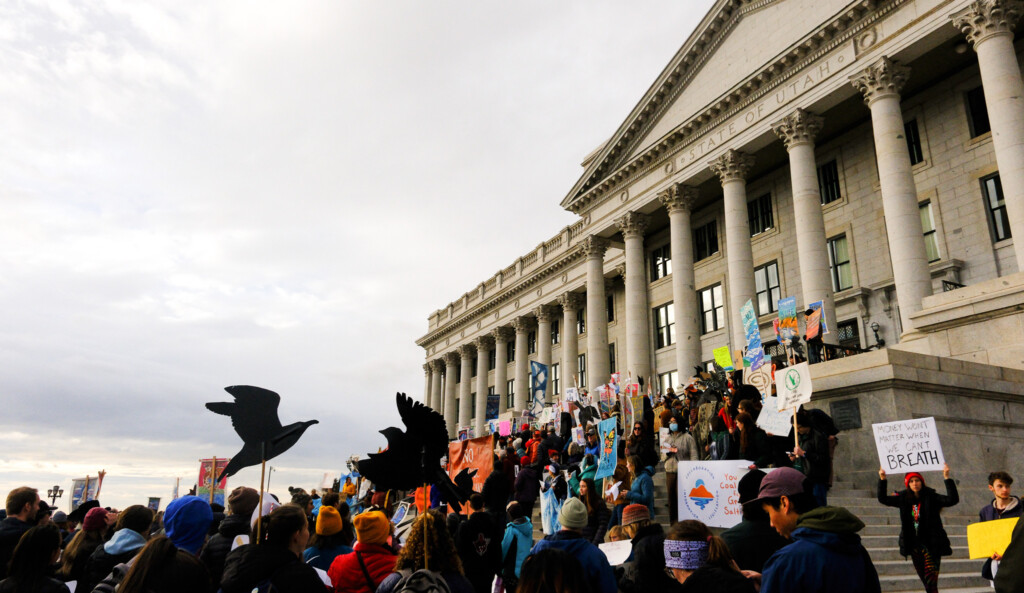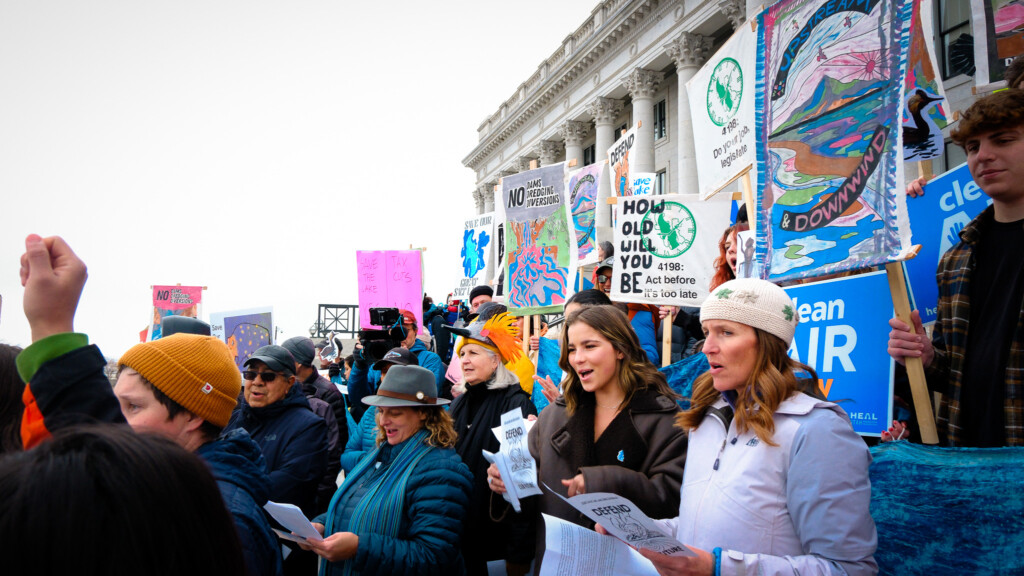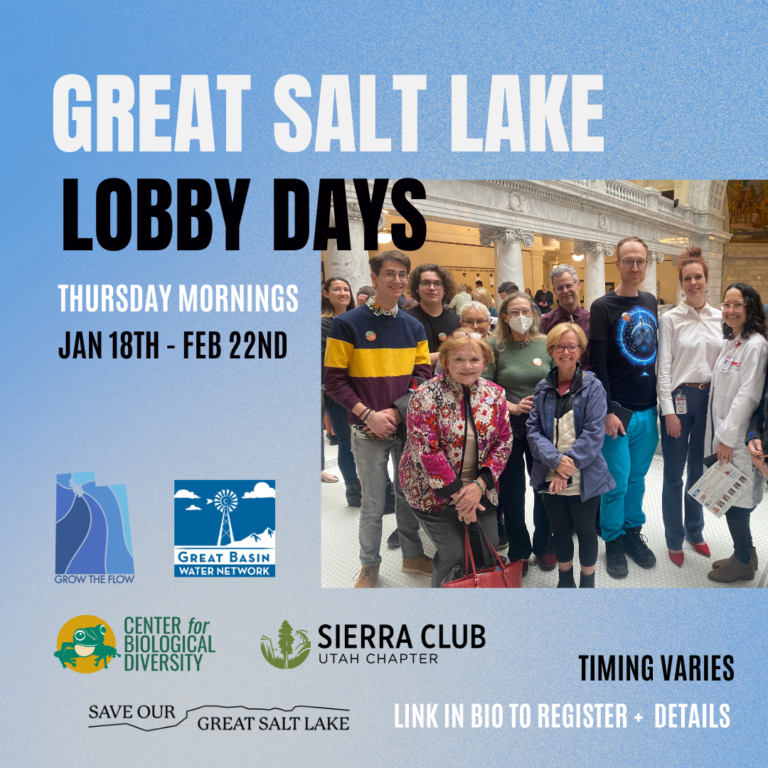Hello Water Warriors,
We’re back with some exciting news from the Nevada Supreme Court, a recap of the Rally for Great Salt Lake, and another update from the 2024 Utah Legislative Session with a breakdown of a few key bills we’re watching.

Utah Legislative Session Update Week #2
S.B. 18: Water Modifications (sponsored by Sen. Scott D. Sandall and Rep. Casey Snider) This bill aims to address concerns around leasing water, especially among agricultural producers, by designating “saved water” as a beneficial use in an effort to shift the incentives baked into Utah’s “use it or lose it” water laws. If passed, it would make it easier for water rights holders to allow portions of their water rights to flow downstream without jeopardizing those rights and, if properly shepherded, to reach Great Salt Lake.
As the legislature continues to direct hundreds of millions of dollars towards water conservation, especially in agriculture, many are concerned as to whether this funding has actually translated into water for Great Salt Lake, or whether conserved water is being used for other purposes.
This bill does create a mechanism to try and ensure that more water makes it to the lake but concerningly, still leaves room for “saved water” to be leased for new uses.
Status: This bill passed the Senate Natural Resources, Agriculture, and Environment Committee this week and will next be heard on the Senate Floor.
H.B. 280: Water Related Changes (sponsored by Rep. Casey Snider) One of the most controversial water bills we’ve seen so far this session, HB 280 would change how Utah prioritizes and funds water projects, taking power from local jurisdictions and giving it to the Water Development Coordinating Council and the State Water Resources Board.
Instead of planning and prioritization of water projects at the local level, relevant agencies would adopt an annual water infrastructure agency plan to outline their water infrastructure needs, submit this plan to the Water Development Coordinating Council who would then compile agency plans into a draft Unified Water Infrastructure Plan. The Council would develop a prioritization process and then rank the submitted projects for funding.
In essence, this bill would take decisions currently under legislative jurisdiction and give decision-making power to political appointees on the Water Resources Board, replacing the public process of legislation to that of a state board.
By consolidating decision-making into the Water Development Coordinating Council and Water Resources Board, this bill could very well pave the way for senseless and destructive water projects like the Cedar City Pipeline, Bear River Development Project (which would prove disastrous to Great Salt Lake) and the Lake Powell Pipeline.
Status: This bill has not yet been heard in committee.
H.B. 11: Water Efficient Landscaping Requirements (Sponsored by Rep. Doug Owens) HB 11 seeks to mandate a reduction of nonfunctional turf on new government construction (or re-landscaped properties) in the Great Salt Lake Basin to just 20% of a project’s overall landscaping. After failing in the Senate last year, this bill has narrowed its scope to government properties in just the Great Salt Lake Basin.
Like most things coming out of the Utah Legislature, this bill doesn’t go far enough, but it’s a practical and valiant effort by Rep. Owens to move the needle however possible given the tough political climate. Owens admits that this bill won’t set records for the amount of water it will save but that it’s still a critical step forward by Utah’s government to show the state’s commitment to municipal conservation. This bill does not place any limitations on “functional turf” i.e. parks, athletic fields, golf courses, etc. It’s the bare minimum, but as Rep. Chew put it during committee hearing, “somebody has gotta start somewhere.”
Status: This bill passed the House this week and will be up in the Senate Committee in the coming weeks.
Nevada Supreme Court Affirms Water for Wildlife, Not Coyote Springs
The Nevada Supreme Court dropped a major ruling in the saga regarding the Lower White River Flow System on Thursday, setting a new precedent for managing groundwater flows and protecting wildlife.
The ruling comes after years of haggling between every interest group one could imagine: The State Engineer, SNWA, mines, power plants, tribes, irrigators, waste management, small municipalities, developers, environmentalists, the LDS church, and the Lincoln County-Coyote Springs-Vidler cabal. The battle began after the State Engineer issued order 1309, setting a new multi-basin management regime to tackle over-appropriated, over-pumped basins that have hydrologic connections. A bevy of interests started suing the state, which led to a district court opinion that ultimately led to the NV Supreme Court appeal.
In short, this decision gives the State Engineer clarity that groundwater and surface water systems are connected. It also ensures that the state engineer has a duty to keep water in rivers, streams and spring systems to uphold the public interest and protect wildlife. The ruling also affirmed that the state engineer has broad management abilities when it comes to bringing basins back in balance.
One of the major outstanding issues is the case will be remanded to a district court to address issues of water availability in the Lower White River Flow System, the 6-basin groundwater system that ultimately flows into the Muddy River in the southeastern part of Nevada. This remand stems from pump tests and other hydrologic analysis by the state and the respective hydrologists for litigants conducted during the past 10 or so years. In other words, the same crew of people suing each other will now fight over how much water actually exists in that patch of the desert.
This will have major implications for Coyote Springs, which believes that there is more water than what many parties believe exists.
This is a strange bedfellows situation that will stir legislative and legal brouhahas for years to come. But the point is that, after years of fighting over the process, now parties will fight over the substance and begin to answer two of the hardest questions in any desert: How much water is left and how long will it last.
GBWN has spent years warning about the perils of Coyote Springs. Today’s ruling is not the final nail in the coffin. But it is not the first nail either. Water from a single source, no matter the lines on a map, must be managed to protect senior rights. And now, with this ruling, wildlife is going to get a fair shake too.
Read Daniel Rothberg’s analysis here. And, of course, you won’t want to miss Patrick Donnelly’s take.
Over 1,200 Attend the Rally for Great Salt Lake

We had a fantastic turnout with over 1,200 people on Saturday at the Rally for Great Salt Lake! Thank you to everyone who joined us. It was truly an inspiring day full of love and community for Great Salt Lake.
Catch the recording here and a recap with deputy director Chandler Rosenberg here.

For those interested in engaging more deeply with the Utah legislative session, join GBWN and our partners for Great Salt Lake Lobby Days every Thursday throughout the session. Each week, we’ll review the bills du jour, provide some hands-on lobbying training, and equip you to lobby your representatives. Timing and location varies slightly each week. Register below for details.
